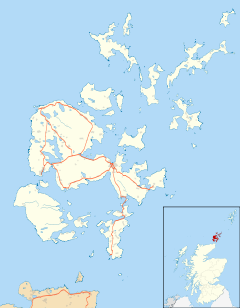
Maeshowe is a Neolithic chambered cairn and passage grave situated on Mainland Orkney, Scotland. It was probably built around 2800 BC. In the archaeology of Scotland, it gives its name to the Maeshowe type of chambered cairn, which is limited to Orkney.

Orkney, also known as the Orkney Islands, is an archipelago in the Northern Isles of Scotland, situated off the north coast of the island of Great Britain. Orkney is 10 miles (16 km) north of the coast of Caithness and has about 70 islands, of which 20 are inhabited. The largest island, the Mainland, has an area of 523 square kilometres (202 sq mi), making it the sixth-largest Scottish island and the tenth-largest island in the British Isles. Orkney's largest settlement, and also its administrative centre, is Kirkwall.

Kirkwall is the largest town in Orkney, an archipelago to the north of mainland Scotland.

Stromness is the second-most populous town in Orkney, Scotland. It is in the southwestern part of Mainland Orkney. It is a burgh with a parish around the outside with the town of Stromness as its capital.

Sanday is one of the inhabited islands of Orkney that lies off the north coast of mainland Scotland. With an area of 50.43 km2 (19.5 sq mi), it is the third largest of the Orkney Islands. The main centres of population are Lady Village and Kettletoft. Sanday can be reached by Orkney Ferries or by plane from Kirkwall on the Orkney Mainland. On Sanday, an on-demand public minibus service allows connecting to the ferry.

Eday is one of the islands of Orkney, which are located to the north of the Scottish mainland. One of the North Isles, Eday is about 24 kilometres from the Orkney Mainland. With an area of 27 km2 (10 sq mi), it is the ninth-largest island of the archipelago. The bedrock of the island is Old Red Sandstone, which is exposed along the sea-cliffs.
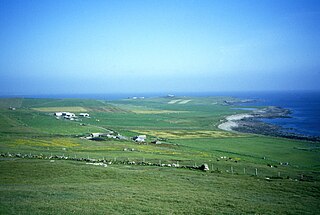
Westray is one of the Orkney Islands in Scotland, with a usual resident population of just under 600 people. Its main village is Pierowall, with a heritage centre, the 15th-century Lady Kirk church and pedestrian ferry service to nearby Papa Westray island. Westray has a number of archeological sites dating from 3500 BC, and remains of several Norse-Viking settlements. The spectacular sea cliffs around Noup Head are home to thousands of seabirds.
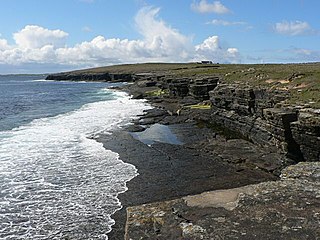
Papa Westray, also known as Papay, is one of the Orkney Islands in Scotland, United Kingdom. The fertile soil has long been a draw to the island.

The Northern Isles are a chain of islands off the north coast of mainland Scotland. The climate is cool and temperate and highly influenced by the surrounding seas. There are two main island groups: Shetland and Orkney. There are a total of 36 inhabited islands, with the fertile agricultural islands of Orkney contrasting with the more rugged Shetland islands to the north, where the economy is more dependent on fishing and the oil wealth of the surrounding seas. Both archipelagos have a developing renewable energy industry. They share a common Pictish and Norse history, and were part of the Kingdom of Norway before being absorbed into the Kingdom of Scotland in the 15th century. The islands played a significant naval role during the world wars of the 20th century.
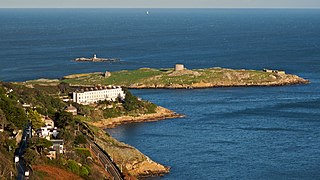
Dalkey Island is an island for which the nearby village of Dalkey is named. It is an uninhabited island located in the county of Dún Laoghaire-Rathdown, about 16 km (9.9 mi) south of Dublin and 3 km (1.9 mi) south of Dún Laoghaire harbour. An important site of pilgrimage for centuries, it has been known as "St Begnet's Isle" since records began. The earliest reference to 'Dalkey Island' is from c. 1782. The island had a population of 8 in 1841.

The Hebrides were settled early on in the settlement of the British Isles, perhaps as early as the Mesolithic era, around 8500–8250 BC, after the climatic conditions improved enough to sustain human settlement. There are examples of structures possibly dating from up to 3000 BC, the finest example being the standing stones at Callanish, but some archaeologists date the site as Bronze Age. Little is known of the people who settled in the Hebrides but they were likely of the same Celtic stock that had settled in the rest of Scotland. Settlements at Northton, Harris, have both Beaker & Neolithic dwelling houses, the oldest in the Western Isles, attesting to the settlement.

Prehistoric Orkney refers only to the prehistory of the Orkney archipelago of Scotland that begins with human occupation. Although some records referring to Orkney survive that were written during the Roman invasions of Scotland, “prehistory” in northern Scotland is defined as lasting until the start of Scotland's Early Historic Period.

Links of Noltland is a large prehistoric settlement located on the north coast of the island of Westray in Orkney, Scotland. The extensive ruins includes several late Neolithic and early Bronze Age dwellings and is place of discovery of the Westray Wife figurine, first uncovered during an excavation in 2009. Historic Environment Scotland established the site as a scheduled monument in 1993.

The Lady Kirk at Pierowall is a ruined 17th-century church on the island of Westray, in Orkney, Scotland. The church was built in 1674, on the foundations of the 13th-century church. Two 17th-century grave-slabs, in excellent condition, are set into the interior wall of the chancel and are now protected by glass screens. The graves display fine lettering and 17th-century images of mortality, engraved in high relief. Historic Environment Scotland established the site as a scheduled monument in 2014.

Westside Church,, is a ruined 12th century church located on the island of Westray in Orkney, Scotland. Archaeological excavations at the site suggest that the church is related to a nearby late Norse settlement. Historic Environment Scotland established the site, which includes the church and surrounding cemetery, as a scheduled monument in 1921.

Prehistoric art in Scotland is visual art created or found within the modern borders of Scotland, before the departure of the Romans from southern and central Britain in the early fifth century CE, which is usually seen as the beginning of the early historic or Medieval era. There is no clear definition of prehistoric art among scholars and objects that may involve creativity often lack a context that would allow them to be understood.
Huna House is a Victorian building located in the small village of Huna in Canisbay, north of Caithness. Built in 1870 as the Huna Hotel, it is listed as a historic place at Historic Environment Scotland. The hotel, located on the eastern edge of a rocky coastline and an intertidal sandbank from Huna House to Scotland's Haven, sits on a short cliff with views of the Island of Stroma, the double-lighthouse of Pentland Skerries, and the Orkney Islands.

St Boniface's Church, Papa Westray is a historic church and graveyard located on the island of Papa Westray in Orkney, Scotland. The site of the church dates back to the Iron Age and was possibly used later as a Christian monastery. The present church was built in the 12th century and was remodeled in 1710. A 12th-century Norse hogback gravestone lies to the east of the church. Two Pictish cross-slabs were uncovered in the graveyard in the 20th century, and were later moved to museums. Historic Environment Scotland established the site as a scheduled monument in 1959.

St. Mary's Chapel is a ruined 12th century chapel found on the island of Wyre, in Orkney, Scotland. It is thought to have been built by a Norse chieftain, Kolbeinn hrúga or his son, Bjarni Kolbeinsson, Bishop of Orkney. The now roofless Romanesque style building was originally constructed of local rubble and lime mortar. During the late 19th century, the building was restored. Historic Environment Scotland established the site, which includes the church and walled burial ground, as a scheduled monument in 1929.
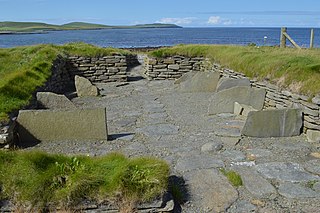
Quoygrew, Westray is the site of a medieval Norse settlement on the island of Westray in Orkney, Scotland. Established as a small farmstead most likely between 900 and 1000 AD, and later expanded in 1200, Quoygrew includes the remains of medieval and post-medieval buildings that range in date from the 10th to the 16th centuries. The 1 hectare farmstead was continuously occupied until the early 20th century. Historic Environment Scotland established the site as a scheduled monument in 2014.

